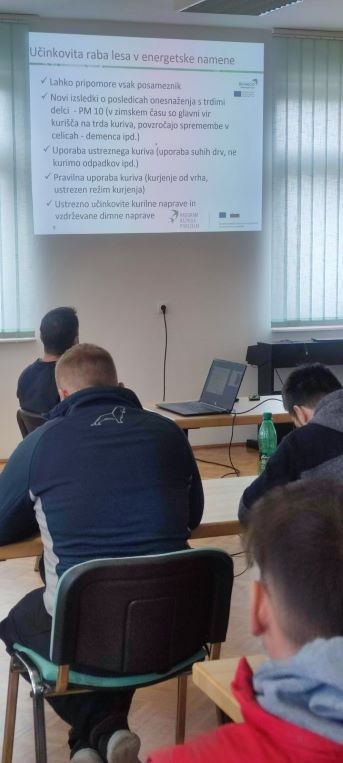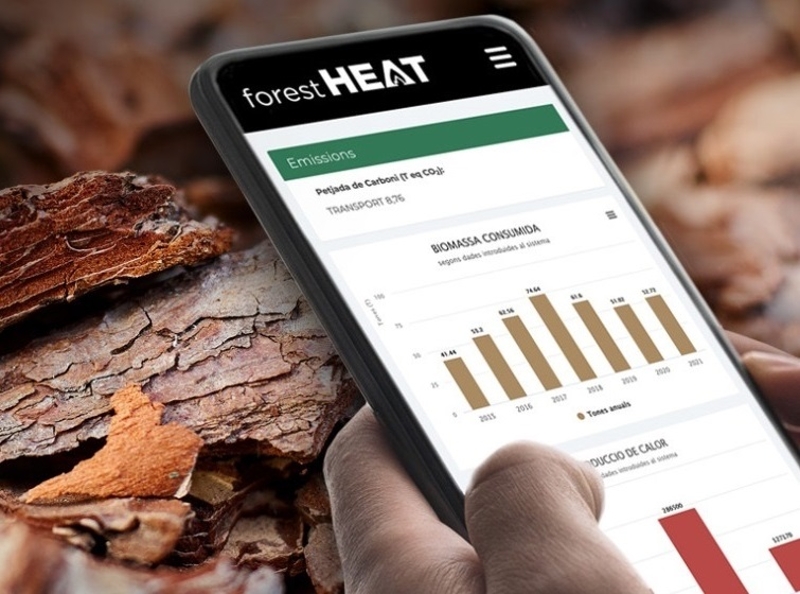
Meeting in BIT Congress, Lleida (spain)
In the framework of the BIT Congress, the meeting of biomass working group was carried
With the objective of the transition to a low carbon economy, some countries and regions in Europe are developing energy and land use policies in separate ways by different administrations.
To improve the energy sector in balance with the natural resource a challenge is to work on bridging those conflicting views and policies.
BIO4ECO aims to improve regional and national policy processes and policy implementation and delivery addressing the transition to a low carbon economy, in relation with renewable energy use, energy efficiency of building, and forest and agricultural biomass.
The main expected outcomes are:
BIO4ECO will organise interregional and local learning process by thematic workshops, study visits and local stakeholder groups meetings, to achieve a greater integration among the lessons learned. These are going to be the cornerstone of the learning process.
Topics that will be worked in these events are the following:
€1,625,610.00
Low-carbon economy
Each partner will base their Action Plan on their current and expected policy challenges, and will integrate the lessons learned throughout the project with these exchange activities.
In the case of bioenergy policies, there is a strong multi-sectorial element, and Action Plans will take into consideration policy areas where partners have direct legal competence, and other areas where they have shared legal competence and will have to coordinate with other departments/administrations.
This is a very important aspect of this project as many policy challenges linked to the regional development of bioenergy strategies are indeed the legislating across policy areas.
Investment Priority 4.1 aims at: reducing the dependence on fossil fuels and increase the thermal uses of biomass, through the development and implementation of the Regional Strategy for the energetic development of forest and agricultural biomass (RSFAB).
Its main objectives are to ensure the adequate ecological and market equilibrium between uses of biomass feedstocks; prioritise public investments according to efficiency and growth; guarantee a sustainable production and management of energetic resources; set a general framework for a future low-carbon regional strategy; and impulse research and innovation in this field.
It is an essential piece of a future bioeconomy/low carbon regional strategy, in the sense that the region is void of fossil fuel reserves and has an enormous potential with primary biomass excess (both agricultural and forestry). It sets an ambitious objective of multiplying by 2.5 the current consumption of biomass-based energy. This in turn will create pressures on several other policy areas: energy efficiency, urban planning, waste management and regulation, agricultural and forestry production, industrial policy, biodiversity, water availability, air pollution, etc.
The Priority 4.1 needs improvement creating sufficient leverage to encourage and promote investments from the private sector, as well as further coordination with other regional policy instruments from different policy areas.
Regional Climate and Energy Programme is linked to Europe 2020, Regional Development Programme 2017 and Sustainable Growth and Jobs 2014-2020, Structural Funds Programme for Mainland Finland (ERDF, ESF).
One of the three foci of North Karelia´s Smart Specialisation Strategy is “Forest bioeconomy” which consist of forest bioenergy, decentralised biorefinement and wood materials, forest technology and the logistics of wood procurement, bioinformation economy (for example forest inventories and management of forest information) and sustainable multiuse of forests and nature.
Forest-bioeconomy is an essential theme in the North Karelian application of smart specialisation. It is based on more innovative utilisation of our forest resources.
It would be useful to emerge the Climate and Energy Programme and the Forest Bioeconomy Foci of the RIS3 strategy into a regional bioeconomy strategy that would combine aspects of environmental sustainability and increase in region´s competiveness. Intersectoral cooperation should be enhanced – for example, region´s RIS3 strategy has two separate foci of forest bioeconomy and technology and materials which are very much interlinked and should not be developed separately.
The overall idea would be to create from the experiences gained in this project a “Smart Bioeconomy Region Strategy” that would be part of all the key regional development documents (Regional Development Programme POKAT 2021, ESI Funds 2021+).
The National Bioeconomy Strategy (NBS) sets strategic goals and principles for bioeconomy development. Some objectives are: effective use of land resources taking into account agriculture and forestry measures impact on GHG emissions and CO2 removals; biomass contribution to energy independence; new job creation and revenue generation in rural communities.
NBS integrates and improves existing policy documents such as Latvia’s sustainable development strategy 2030; Latvia’s long term energy strategy 2030; Forest sector and related sectors development baselines. Further development of sectors of national significance such as forestry, agriculture and other land uses is also one direction for knowledge based bio-economy area in the Smart Specialization strategy for research and innovation in Latvia. The new challenge for land use sectors are raised also in the national 2030 Climate and Energy Policy Framework.
Improvement is needed for: strategic planning at national level and linking improvement with regional development planning based on existing local resources and stakeholders involvement in that process; creating sufficient support instruments to incentivise private sector investments within the bioeconomy strategy implementation; and enhancing effective “translation” of newest scientific knowledge on innovation potential to field-level solutions.
The Territorial Energy Climate Plan (PCET) aims at engaging municipalities in a climate mitigation and adaptation strategy, with an action plan covering all activities which have an impact on GHG emissions.
The Grenelle law approved in 2010 has made the PCET mandatory for joint municipalities above 50 000 inhabitants. The current “energy transition” law plans on deploying this tool by making it mandatory for joint municipalities above 20 000 inhabitants by the end of 2018. It also adds a mandatory section concerning air quality, consistent with Air Energy and Climate Regional Strategies (SRCAE).
Considering the rural context of the next generation of mandatory PCET, the effects of both agriculture and forest sectors should be addressed in a more advanced and differentiated way. To optimize the overall contribution of the forest sector to the operational objectives of the PCAET, 3 effects must be taken into account: carbon storage, depending on forest management practices; fossil fuels substitution, using forest biomass for energy (heat and electricity) production; carbon sequestration, using timber as one of the best material for green and energy efficient buildings.
This specific “forest sector assessment” needs an improvement of the tools used, such as Clim'agri developed by the French Environment and Energy Agency (ADEME), as well as a greater awareness and mobilization of stakeholders, and first of all of forest municipalities.
NFP is a fundamental strategic document aimed at determining the national policy of sustainable development of forest management. The main principles of the NFP are directed towards the preservation of forests and provision of a multipurpose role, which includes the environmental, social and economic aspects.
NFP also presents the implementation of the Environmental Action Programme at the national level, which defines four priorities: energy and climate change, nature and biodiversity, environment and health, and the quality of life, natural resources and waste. The EU’s Thematic Strategy on Sustainable Use of Natural Resources meanwhile presents a reference point for the NFP, which is based on regional characteristics and ecosystem approach.
The objectives of this policy which refers to biomass issues are: higher share of use of wood in Slovenia’s primary energy balance and increase the scope of activities using wood, in particular in rural areas, where those activities considerably contribute to their development.
The NFP needs improvement in three aspects:
1. Creating better basis for more active role of field experts, regarding the promotion of efficient use of biomass for energy.
2. Creating a basis and guidelines for awareness raising and pooling of the forest owners, especially in areas with a higher share of low quality wood stands.
3. Better coordination with other policy areas wich offer incentive to investments in bioenergy projects.
The Operational Programme "Innovation and Competitiveness" (OPIC) strategy is closely related to the objectives for Growth and Jobs and Bulgaria‘s contribution to achieving the three complementary types of growth according to Europe 2020. It directly engages in smart and sustainable growth and has also been developed in line with the objectives the 2020 Energy Strategy of the Republic of Bulgaria, representing the country's vision for the sector in accordance with the current European framework and the global trends in energy technology.
OPIC is built upon six areas of intervention and includes Area 4 “Energy technologies and energy efficiency”. Four priority axes with relevant investment priorities have been identified, and of particular relevance to the project proposal is Axis 3 “Energy and resource efficiency”. It is divided into two investment priorities: 3.1 Energy technology and energy efficiency and 3.2 Resource efficiency.
OPIC needs to be improved in terms of providing conditions for supporting the implementation of Axis 3 and in particular, connected with the production and usage of solid wood biomass. According to the preliminary initiative of the Executive Forest Agency, the Action Plan to be developed in Phase 1 will be implemented in pilot areas/ enterprises, on the basis of the best EU practices identified and subsequently financially supported by OPIC through concrete projects.
Action 4.2.1 of the Investment Priority 4.b is specifically addressed to grant incentives aimed at: reducing energy consumption in enterprises and in production areas; reducing gas emissions in enterprises and in production areas; and favouring the installation of renewable sources energy production plants for enterprises’ consumption (including biomass plants) and giving priority to high-efficiency technologies.
This action is then intended to promote the rationalization of consumption and the minimization of polluting emissions from the production of SMEs. In fact, since June 2014, in the Abruzzo region there were 128,388 active SMEs, being then clear how crucial is the issue of ensuring energy efficiency and production from renewable energy sources in the industrial sector, to achieve the objective of reducing the consumption of electricity, without forgetting that this reduction affects also enterprises’ competitiveness.
Furthermore from 2010 in Abruzzo there was a trend reversal of CO2 emissions (respectively -37% compared to 2005 and -10.9% compared to 2010) which decreased up to 4,1 ton/inhab, 3.3 points below the national average (7,4 ton/inhab).
In terms of energy requirements, in 2013 energy consumption of the Abruzzo region (amounting to 6,137.3 GWh) was only partly covered by the regional production (3,915.9 GWh), resulting in a deficit of electricity equal to 2,221.4 GWh; the electricity needs of the industrial sector amounted to 2,613.4 GWh.
The ROP aims at promoting smart sustainable and inclusive growth in all regions in Romania. The programme addresses the major development challenges for Romania: regional competitiveness, sustainable urban development, low-carbon economy, and economic and social infrastructure at regional and local level.
The ROP aims to continue implementing the strategic vision of regional development in Romania, completing and developing the directions and priorities of the National Development Plan. The priority axis 3 of the ROP 2014-2020 “Support for the transition to a low carbon missions economy», investment priority 3.1 «Support to energy efficiency, intelligent management of energy and for use using renewable energy sources in public infrastructure, including public buildings and residential houses».
During the implementation phase, the beneficiaries should adopt the most efficient solutions to increase the use of renewable energy in public buildings. The best solutions provided by project partners during the exchange/transfer of good practices will improve the implementation of ROP in terms of results and impact. We appreciate that the policy instrument should provide additional guidelines to project beneficiaries in order to help them identify the best solutions and models in using renewable energy sources and assist them in making the best use of the European initiatives like: Covenant of Mayors, Smart Cities, Structural Funds, etc.

In the framework of the BIT Congress, the meeting of biomass working group was carried

Slovenia Forestry Service has organised the last Stakeholder meeting, where we gathered stakeholders on a meeting in Ivančna Gorica, on 26.9.
The FNCOFOR organized a study visit on 21 and 22 September 2022

The Interreg Europe Secretariat is currently looking for one Policy Officer (10 months contract).
On 7-8 June the BIO4ECO project partners and their stakeholders met for the 3rd interregional meeting

The Interreg Europe Secretariat is currently looking for one Policy Officer. The position is based in Lille, France.
On 31st of March - 1st April, we travel to Slovenia and visit Slovenia Forest Service (SFS Regional Unit Kočevje), and diferent companies.

ForestHEAT is an app to manage data and information related to heating wood biomass systems. It creates graphs and report in an easy way on any ICT device.

The Interreg Europe Secretariat is currently looking for one Project Finance Officer. The position is based in Lille, France.

Interreg Bio4Eco organizes on line event about:. Learned lessons from wood‐based energy sector as a result of CoViD crisis impact